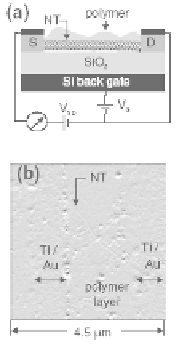Biomedical Engineering Reference
In-Depth Information
. [143] fabricated noncovalently functionalized SWCNTs
FETs by simply submerging nanotube network FETs in an aqueous
solution of PEI and starch overnight. PEI-starch polymer-coated
SWCNTs FETs devices had electrical
Star
et al
n
-type characteristics and were
used as CO
gas sensors. The proposed sensing mechanism was
based on chemical interactions briefly discussed: starch polymer
is hygroscopic and its presence will locally increase the amount
of water. Due to water presence, the amine groups of the PEI can
react with dissolved CO
2
gas molecules to form carbamates. These
introduce scattering centers that decrease the carrier mobility in
the SWCNTs, thereby increasing the electrical resistance. With this
polymer CO
2
gas recognition layer, the functionalized SWCNT-FET
sensors exhibited a high sensitivity, fast time, good linearity and
complete reversibility for CO
2
concentrations widely ranging from
0.05 (500 ppm) to 10% in air, as shown in Fig. 9.25.
2
Figure 9.25
(
) Schematic representation of a field-effect transistor
(FET) device with a carbon nanotube contacted by two
Ti/Au electrodes (source and drain) and a silicon back-gate.
Carbon nanotube conducting channel is exposed to gases and
covered by a polymer layer. (
a-Left
) Atomic force microscopy
(AFM) image of the actual nanotube device coated by
polymer layer. (
b-Left
a-Right
) Response of the SWCNTs FET sensor
to CO
gas showing I
(t) of the CNTs FET device recorded
2
SD
under bias voltage (V
) of 0.2 V and gate voltage (V
) of
SD
G
+6 V in a flow cell (air, RT, RH = 80%). (
b-Right
) Calibration
curve of the sensor at 0-10% CO
gas concentrations. This
figure is reprinted and adapted with permission from Wiley-
VCH [143].
2




